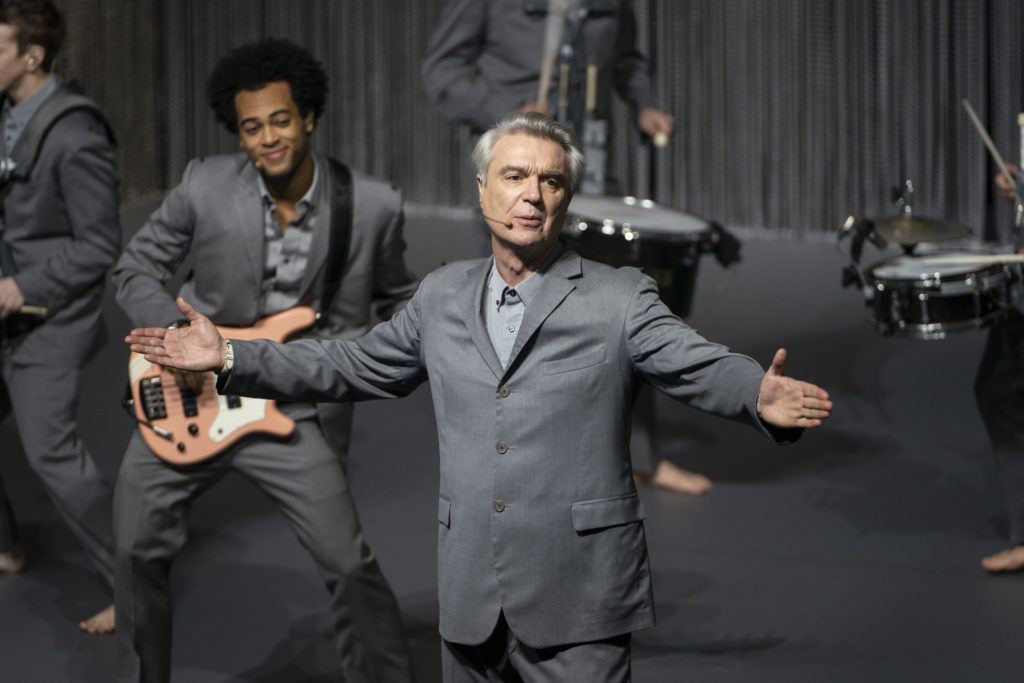David Byrne’s American Utopia

Image courtesy TIFF.
“My Name is David Byrne. I can’t take credit for that. I had no choice in the matter.”
The Randy Newman of New Wave Dadaism, Byrne’s career began as the frontman for The Talking Heads, formed in 1975 with fellow Rhode Island School of Design students Tina Weymouth and Chris Frantz. The Heads were among a handful of acts signed out of CBGB’s in the stable of artists launched by Sire Records founder Seymour Stein.
It’s important to frame Spike Lee’s homage to Jonathan Demme’s 1984 breakthrough concert film, STOP MAKING SENSE. Shot at New York’s Hudson Theatre on Broadway, Lee’s movie attempts a similar kind of intimacy—overhead, behind, even center stage, as close as the camera operators can get. But I’m reminded of a remark made to me when I was a columnist for the college paper trying to get an interview with prog rock veterans, Rush. The Atlantic rep simply replied, “They’re too big for that.”
And so it goes, at 68, Byrne, who attributes his emotionally-distant affect to Asperger Syndrome¹, comes across exactly as Weymouth described in a 2018 interview inThe Guardian. He isn’t connecting so much with the audience as he’s connecting with the moment. While Demme’s documentary gives us an intimate look at the Talking Heads, Lee’s film paints a distant picture, of a man curiously out of touch with his surroundings still trying to understand them.
“Meeting people is hard,” Byrne says in between songs. “These people over here, they all met through apps. Totally working for them. These people over here, don’t need apps. They’re just supremely confident.”
The audience is, just as in John Cage’s case, a prop—a component of the performance art at work. They’re used like the chain curtain in one number through which light filters—imitating the aperture grille of the Sony Trinitron he recalls having purchased with his first record advance. He imposes a condition on people for the purposes of the narrative he’s constructing.
“Objectively I could never figure out why, why looking at a person should be any more interesting than looking at any other thing. Looking at people, that’s the best,” he says, just before launching into “This Must Be The Place,” from the 1983 Talking Heads album Speaking In Tongues.
The film’s 135 minutes spans a variety of works from various phases of Byrne’s career. One particularly fun number—”Toe Jam” by the BPA, a collaboration of Norman Cook, Iggy Pop, Byrne, and others— is accented by a crimson rim light. It reveals in McLuhan-esque fashion, the purpose for the weirdness of having twenty people perform deconstructed instruments that, made whole could’ve been played by four or five: the connection between people on and off stage is the performance. The more human, the better.
The collective works of the Heads, to me, come across more organically than his solo efforts. They’re the result of friction—which some creatives misinterpret as an obstacle, yet completely essential to the collaborative nature of music and, particularly, sound recordings. What one wants isn’t necessarily how or why people have jobs. It’s a privileged viewpoint² to think otherwise. Consider where David Byrne would find the resources to do this show if he were nobody. It’s the virtue of there being a market for Talking Heads’ music that he possesses the financial freedom to engage in such experimental fare.
However, whether it’s Byrne’s “I Dance Like This,” Kurt Schwitter’s nonsense poem, “Ursonate,” Edgard Varese’s “Poeme Electronique,” or Carolee Schneeman’s “Inner Scroll,” experimental art’s crucial role in cultural evolution stands well-established. We don’t have to comprehend or even like David Byrne to know that we need him.
DAVID BYRNE’S AMERICAN UTOPIA is currently screening at the 45th Toronto International Film Festival.
- In 2009, Byrne stated he had “Aspergers Syndrome”, though no formal diagnosis was put forth; since the publication of the DSM-V, due to its contentious nature, the diagnosis of “Aspergers” has been re-classified under the broader “autism spectrum disorder.”
- It wouldn’t be a Spike Lee Joint without the backhand, to remind us of our privilege. In this case, it’s Byrne’s cover of Janelle Monae’s “Hell You Talmbout.”